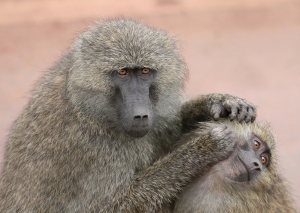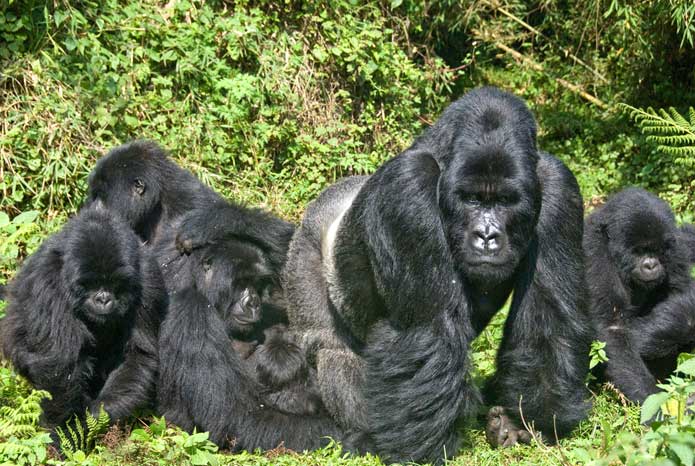“I get by with a little help from my friends.”
The more we look, the more we find. This is especially true when it comes to the social dynamics of animals. Scientists continue to document the complex nature of social relationships, particularly in birds and mammals. It seems we are constantly saying, “I didn’t know animals did that!”
While there is great value in understanding the sociality of all animals, we have an extra interest in understanding the relationships of our closest relatives because they can help us understand how our own social relationships evolved. By exploring the nature and value of social relationships in apes and other primates, we are better able to understand the evolutionary context of our sociality.

A new paper in the journal Ethology describes the results of a nine-year-long study of the social relationships of mountain gorillas at the Karisoke Research Center in Rwanda. (This facility was founded by the late Dian Fossey, the subject of “Gorillas in the Mist” and one of the “trimates,” the founders of the modern study of primatology.)
The researchers, led by Dr. Stacy Rosenbaum of the University of Chicago and the Lincoln Park Zoo, focused specifically on how relationships between young gorillas and older males developed and changed as the young gorillas matured into adolescents, and then into young adults.
Measuring social relationships in gorillas
There are many ways we can document social relationships, but in this study, the researchers used the simple technique of monitoring who was close to whom. While this gives no details about what the gorillas actually do when close to each other, proximity measurements are a reliable proxy for social relationships because many previous studies have shown that, in apes, frequent close proximity indicates affiliation.
Gorillas that spend a lot of time together are seen grooming each other, eating together, and even playing. Animal behaviorists call this “affiliation” but “friendship” seems more appropriate. Social animals form long-lasting alliances that have great value to them in a variety of ways. Pure rivals, on the other hand, will avoid each other. Actual skirmishes are fairly rare. Thus, it is a safe conclusion that time spent in close proximity is an indirect, but accurate measure of friendship in gorillas.

When I asked her straight out if we could call these relationships “friendships,” Dr. Rosenbaum hesitated before answering, not out of uncertainty, but because the scientific community generally eschews such ‘touchy-feely’ language to describe relationships in animals. Finally, she responded, “You know, I would. I know that’s a controversial word in the field of animal behavior, but I actually think that… people ought to be able to use that word.”
Animal friendships
Simply put, social animals form long-lasting friendships because these friendships bring value, both for survival and for reproductive success. Alliances can include food sharing, cooperative hunting/gathering, predator warning calls, and many more obvious survival advantages.
Alliances also help with reproductive success in a variety of ways. Allies assist each other in caring for youngsters, fighting off rivals, and establishing and maintaining a high rank in the dominance hierarchy. In many species, including gorillas, there is a strong correlation between rank and reproductive success. High-ranking animals get access to more mates and higher-quality mates, and their offspring are less likely to be killed by rivals. Having allies helps with all of this, and the higher-ranked the allies, the better. Everyone wants to be friends with the rich and powerful.
The mountain gorillas of Karisoke Research Center
There are two species of gorilla, the Western Gorilla (Gorilla gorilla) and the Eastern gorilla (Gorilla beringei). Mountain Gorillas are a subspecies of Eastern Gorilla and only two populations remain. One of them, the subject of the current study, is located in the Virunga volcanic mountain range in Rwanda and has been continuously monitored by scientists at the Karisoke Research Center, funded by the Dian Fossey Gorilla Fund International, for almost 50 years.

It was long believed that gorillas lived exclusively in the harem social structure, that is, one dominant adult male, the silverback, along with many adult females and their offspring. However, the Virunga population of mountain gorillas has been living in multi-male groups for over two decades. Although each group has one dominant silverback, additional silverbacks are also present, stratified in a dominance hierarchy with reproductive productivity assigned accordingly.
This appears to be a recent, strange, and possibly unique social structure among gorillas. It has yet to be observed in any of the western gorilla populations or in the other populations of eastern gorillas. Those all use the harem system strictly, so far as we know. This large multi-male framework provides a rich social environment in which to monitor how the gorillas create and nurture their relationships.

Friends in high places
The study by Rosenbaum, et al, looked at a specific social relationship, that of adult males with young gorillas of both sexes. Specifically, the researchers analyzed how the relationships changed as the young gorillas aged and became young adults themselves. As mentioned above, the strength of the relationship was determined using proximity measurements – how much time they spent in close contact.
To accomplish this, Dr. Rosenbaum and her colleagues organized the proximity data into “dyads.” Dyads are pairs of gorillas and the researchers tracked every possible pair-wise combinations between a young gorilla and an older male. This means that each youngster will be in multiple dyads, and so will each silverback. Each “friendship” was then considered separately. The researchers plotted the strength of the relationship over time to see if and how each one changed. (Of course, many dyads were broken due to the death or dispersal of one of the members.)
As previously shown, the proximity measurements accurately revealed that gorillas have stable relationships over time. Gorillas don’t spend time with other gorillas randomly – they have their preferred “friends” and nurture those affiliations over time.

Not surprisingly, dominance predicted friendships reasonably well. Both young males and young females had the strongest relationships with the most dominant males. This makes sense because the most dominant males have something important to offer: protection. Infanticide is not uncommon among adult male gorillas. (In the case of the Rwandan Mountain Gorillas, infanticide is almost always at the hands of males from other troops.) By forming alliances with strong, dominant males, the youngster gorillas are reducing the chance of being killed by infanticidal males from other groups.
What do the older males get out of the relationship? Since the most dominant males father the most offspring, we can assume that they are at least partially motivated by a desire to protect their young from the other males. But there could be more.
Can we call it gorilla mentoring?
There may be additional advantages for both parties besides just protection against infanticide. Young gorillas can learn things from an older male, including strategies for finding food, establishing dominance, warding off rival males with aggressive displays, or even fighting skills.
In particular, a maturing male has much to learn from an older male and the friendship can be seen as a type of mentoring. The young male hopes to learn from the most successful male he can find, hence the preference for the alpha males. Meanwhile, the older males hope to gain the trust and affection of a young whippersnapper who may one day take over as alpha.

I asked Dr. Rosenbaum if this is the gorilla equivalent of mentoring. “You know, I hadn’t conceptualized it that way before, but, in some ways, yes, it does strike me that way. Particularly with the facultative switching that some of the males did… by spending so much time with the up-and-coming dominant males, the young males could be preparing to be in that position themselves one day.”
Sex differences
While it is more readily understandable what a young male has to gain from being friends with a older male, what about the young females? Because females aren’t typically aggressive toward other gorillas (male or female), a reasonable prediction is that their friendships with older males would be different than those of young males.
The researchers confirmed this prediction in two interesting ways. Firstly, the researchers confirmed that, overall, male-male bonds weaken as the younger male gets older, while the female-male bonds actually got stronger as the females matured into young adults.
For the males, despite whatever affection they may have for each other, male-male rivalry will creep in as the young male matures into an adult and this explains why their friendships wane as they age. However, it’s important to remember that friendships and rivalries are not strictly either/or scenarios. (Isn’t the same true for us? We can often be friends with our rivals and rivalrous with our friends.)

Secondly, the researchers found that young females and young males tend to behave differently when their closest friendship is broken by the death or departure of the older male. For females, they will simply spend more time with other older males that they were previously friends with already, but males will try to replace their “top ally” with the most dominant male he can, regardless of whether or not they were previously friends.
This is a key difference and may help us understand the value of friendship to male and female gorillas. A young male simply wants to secure friendships with the highest ranking males that he can, and thus get the most out of the friendship in terms of his own development as a potential future alpha. A young female, however, nurtures her friendships over the long haul regardless of what the older male may offer her.
Why do the females bother?
In fact, the researchers found that younger females will maintain strong friendships with older males long after those males have peaked in terms of dominance and power. This puzzled the researchers. As Dr. Rosenbaum told me, “The males that a female spent a lot of time with when she was little are not, at least on the surface, the best choice of mates by the time she matures. By then, those males would be significantly older, sperm quality probably declines as it does in humans, they’re not the best fighters anymore… They are males that are past their prime.” This begs the question, ‘Why do they do this?’
Of course, some of the young female-older male friendships might have been father-daughter. If so, this could help explain the interest that the older male has in the friendship, but still doesn’t answer why the female continues to care about the friendship even after her father is elderly. (As I get older, I find it increasingly comforting to find that apes do not always discard elderly members of the troop. I digress.)
However, of the 12 male-female dyads, only four were father-daughter and those friendships were indistinguishable from the others. As Dr. Rosenbaum put it, “The males don’t seem to make a social distinction between their own children and those of other males, unlike in chimpanzees where there is evidence of paternal preference.”

This could be a side effect of the strange social arrangement in this population. Since other gorillas seem to live in harems and because the stark difference in male/female body size is typical of harems, there is reason to believe that the multi-male arrangement is very new to these gorillas and they haven’t fully adapted into it. In the case of friendships with younger females, the males may just be behaving as if all the youngsters are their children, even though they are not, because that’s how it would have been in a harem.
When I asked Rosenbaum about this, she replied that “We would expect friendships between children and their opposite-sex parents to be rare because one or the other member of the dyad should disperse to avoid inbreeding. That’s how it usually is in all primates, actually.” This population is odd indeed because not only are multiple males tolerated in these troops, the females disperse (leave their natal troop and attempt to join another one) at a higher rate than the males.
Meanwhile, females give a great deal of costly parental care to their own children, but generally do not care at all for other children. This is the opposite of the older males, who are happy to mentor young males or females, regardless of paternity. That said, the males may be operating under the incorrect behavioral drive that they are in a harem and all the youngsters are their own. In addition, male parenting among mountain gorillas is not very costly. Food is plentiful in the volcanic mountains of Rwanda. As Rosenbaum put it, “They live in a giant salad bowl,” and the males obviously don’t nurse or even carry around the children, like the females do. It’s low-cost for the males to care for the other gorillas while they are young.
This leaves open the question of why females maintain friendships with older males. Not surprisingly, Dr. Rosenbaum told me that this is her next research question. Specifically, she intends to examine how a female’s friendships affect her decision to disperse or not. Hopefully this will shed some light onto what the friendships mean to the females.
A dynamic social arrangement
The key element for understanding the various friendships among the Mountain Gorillas in Rwanda seems to be their recent switch to large multi-male groups from their previous harem arrangement. This changes the relationship that each and every gorilla, male or female, young or old, has with the other members of the troop. Put simply, this changes everything.

Much work remains to be done but it seems possible that the reduction in male-male rivalry and violence may have ushered in a more tranquil, egalitarian, and friendly era among these gorillas. (The same theory has been put forward for human pacification, but by an entirely different mechanism.) Will this social structure last? Are other populations of Gorillas capable of this social tranquility as well? Has our understanding of harem-living species been overly simplistic all along?
One thing is very clear: there are lots of interesting questions one can ask when studying how and why gorillas make friends. Parallels to various types of human friendships are obvious. It goes without saying that we must always be careful not to over-interpret our observations of animal behavior, nor to project human values onto animal relationships. Still, understanding how other apes and other primates find value in their relationships helps to illuminate the origin of our modern human relationships. After all, the human social experience didn’t just spontaneously emerge. Like everything else about us, there is a history to our social structures. And that history matters.
As O. Henry wrote in Heart of the West, “No friendship is an accident.”
-NHL (@nathanlents)

Reblogged this on pankeahomtfy.
LikeLike
It occurs to me that perhaps this tolerance of multi-male groups may be of recent origin in response to human poaching. A lone silverback would be at a disadvantage confronting attacks by multiple humans, having back up seems a good survival strategy. Any thoughts?
LikeLike
It’s an interesting idea and I’m working on another story about Mountain Gorillas, so I’ll discuss it with the Karisoke scientists and see what they say. One problem is that the multi-male arrangement began in the mid-90s. By then, this particular population in Virunga, like the other remaining populations of mountain gorillas, were living entirely within National Parks in Rwanda. While they are certainly not free of poaching there, the threat is drastically reduced to what it once was and to what other populations experience. In other words, the groups switched to multi-male arrangements after they were well on the rebound from the worst of the poaching in the 60s, 70s, and early 80s. Perhaps it was the dynamics of a population that had suffered severe threat and low population size, then stabilized and started healthy and rapid expansion that led to this arrangement as a way to mitigate the effects of genetic drift through inbreeding? That seems like a stretch, too, but one never knows. If you follow my blog, expect to read more about this in the next couple months! And thanks so much for the comment. The interesting discussions are the best part of blogging. Science on.
LikeLike